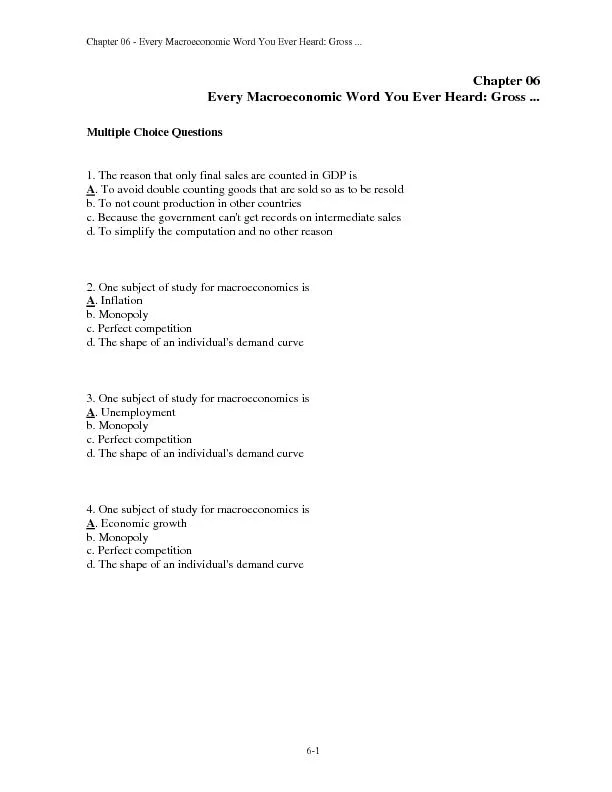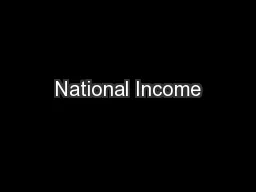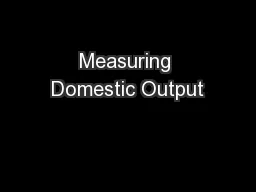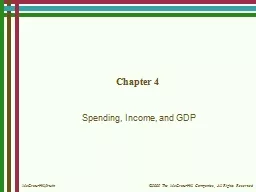PPT-Chapter 7 Measuring Domestic Output and National Income
Author : phoebe-click | Published Date : 2019-06-21
Assessing the Economys Performance National income accounting measures economy s overall performance Bureau of Economic Analysis compiles National Income and Product
Presentation Embed Code
Download Presentation
Download Presentation The PPT/PDF document "Chapter 7 Measuring Domestic Output and..." is the property of its rightful owner. Permission is granted to download and print the materials on this website for personal, non-commercial use only, and to display it on your personal computer provided you do not modify the materials and that you retain all copyright notices contained in the materials. By downloading content from our website, you accept the terms of this agreement.
Chapter 7 Measuring Domestic Output and National Income: Transcript
Assessing the Economys Performance National income accounting measures economy s overall performance Bureau of Economic Analysis compiles National Income and Product Accounts Assess health of economy. Roger . Coupal. , Department of Agricultural and Applied Economics, U of Wyoming. David Finnoff, Department of Economics and Finance, U of Wyoming. Charles Sims, Department of Applied Economics, Utah State University. In measuring Gross Domestic Product, goods produced by foreign firms in the United States areCounted, and so are goods produced by American firms in foreign countriesCounted, but goods produced by Ame www.lancaster.ac.uk/postgrad/murphys4/. s.murphy4@lancaster.ac.uk. office: LUMS . C85. Question 1(a). The data in the table below are for the UK in 2011. All numbers are in £million. .. Source. : UK National Accounts, The Blue Book, . The value of the output of goods and services produced in an economy over a period of time. Increases in National Income mean that the economy has grown – economic growth!. It is assumed that a . richer nation . and . National Income. . National Income Accounting. This measures the economy’s performance by measuring the flows of income and expenditures over a period of time. It does for the economy as a whole what private accounting does for the individual firm or household.. . Fluctuations. Chapter 9. © Dünhaupt, Dullien, Goodwin, Harris, Nelson, Roach, . Torras. Learning Goals. After . today‘s. . lecture. , . you. will . be. . able. . to. :. Describe how unemployment and inflation . in the Short Run. Learning Objectives. Identify the key assumptions of the basic Keynesian . model. Discuss the determination of planned investment and . planned . aggregate expenditure. Analyze . how an economy reaches short-run equilibrium in the basic Keynesian . Macroeconomics: Data and Issues. Learning Objectives. Explain how economist define and measure an economy's output. Use the expenditure method for measuring GDP to analyze economic activity. Define and compute nominal GDP and real GDP. Borkakati. Asst. Professor. Department of Economics. Mangaldai College. National Income . Is defined as total market value of all final goods & services produced by residents of a country while working both within or outside the domestic territory in an accounting year.. TOPIC 1. NI is the value of all goods and services produced in the economy in a year.. It measures the economic performance of a country.. WHAT IS NATIONAL INCOME?. This can be done in 3 ways:. GROSS DOMESTIC PRODUCT (GDP). To understand the structure and level of any economy and the change in it over time, it is essential to know about its net domestic product. Net domestic product shows the flow of goods and services in the economy. Data on net domestic product presents a complete picture of different sector of the economy. . Issues to be . addressed by the HLEG subgroup on income and wealth inequality. Thomas . Piketty. Paris School of Economics. OECD, . January 16. th. 2014. « W. ork. under the “income and wealth inequality” theme would take stock of... . Binod. . Goswami. , Nowgong Girls’ College . MACRO . ECONOMICS. What . is Macroeconomics? . . “Macro” is derived from Greek word “. Makros. ” . meaning Large . (Master PPD & APE, Paris School of Economics). Thomas . Piketty. Academic year 2013-2014 . Lecture 1: Income, capital and growth. (Tuesday November 26. th. 2013). (check . on line. for updated versions).
Download Document
Here is the link to download the presentation.
"Chapter 7 Measuring Domestic Output and National Income"The content belongs to its owner. You may download and print it for personal use, without modification, and keep all copyright notices. By downloading, you agree to these terms.
Related Documents














